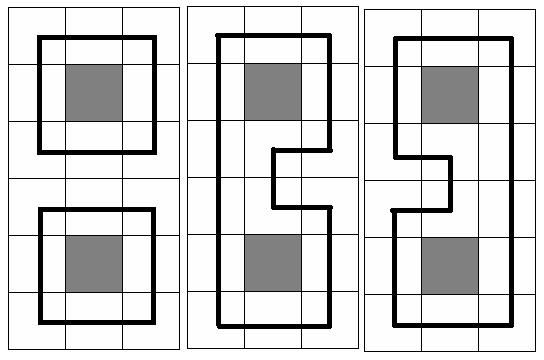hdu1693之插头DP
来源:互联网 发布:mac如何使用财务软件 编辑:程序博客网 时间:2024/06/09 22:57
Eat the Trees
Time Limit: 4000/2000 MS (Java/Others) Memory Limit: 32768/32768 K (Java/Others)Total Submission(s): 2303 Accepted Submission(s): 1124
Problem Description
Most of us know that in the game called DotA(Defense of the Ancient), Pudge is a strong hero in the first period of the game. When the game goes to end however, Pudge is not a strong hero any more.
So Pudge’s teammates give him a new assignment—Eat the Trees!
The trees are in a rectangle N * M cells in size and each of the cells either has exactly one tree or has nothing at all. And what Pudge needs to do is to eat all trees that are in the cells.
There are several rules Pudge must follow:
I. Pudge must eat the trees by choosing a circuit and he then will eat all trees that are in the chosen circuit.
II. The cell that does not contain a tree is unreachable, e.g. each of the cells that is through the circuit which Pudge chooses must contain a tree and when the circuit is chosen, the trees which are in the cells on the circuit will disappear.
III. Pudge may choose one or more circuits to eat the trees.
Now Pudge has a question, how many ways are there to eat the trees?
At the picture below three samples are given for N = 6 and M = 3(gray square means no trees in the cell, and the bold black line means the chosen circuit(s))

So Pudge’s teammates give him a new assignment—Eat the Trees!
The trees are in a rectangle N * M cells in size and each of the cells either has exactly one tree or has nothing at all. And what Pudge needs to do is to eat all trees that are in the cells.
There are several rules Pudge must follow:
I. Pudge must eat the trees by choosing a circuit and he then will eat all trees that are in the chosen circuit.
II. The cell that does not contain a tree is unreachable, e.g. each of the cells that is through the circuit which Pudge chooses must contain a tree and when the circuit is chosen, the trees which are in the cells on the circuit will disappear.
III. Pudge may choose one or more circuits to eat the trees.
Now Pudge has a question, how many ways are there to eat the trees?
At the picture below three samples are given for N = 6 and M = 3(gray square means no trees in the cell, and the bold black line means the chosen circuit(s))

Input
The input consists of several test cases. The first line of the input is the number of the cases. There are no more than 10 cases.
For each case, the first line contains the integer numbers N and M, 1<=N, M<=11. Each of the next N lines contains M numbers (either 0 or 1) separated by a space. Number 0 means a cell which has no trees and number 1 means a cell that has exactly one tree.
For each case, the first line contains the integer numbers N and M, 1<=N, M<=11. Each of the next N lines contains M numbers (either 0 or 1) separated by a space. Number 0 means a cell which has no trees and number 1 means a cell that has exactly one tree.
Output
For each case, you should print the desired number of ways in one line. It is guaranteed, that it does not exceed 263 – 1. Use the format in the sample.
Sample Input
26 31 1 11 0 11 1 11 1 11 0 11 1 12 41 1 1 11 1 1 1
Sample Output
Case 1: There are 3 ways to eat the trees.Case 2: There are 2 ways to eat the trees.
#include <iostream>#include <cstdio>#include <cstdlib>#include <cstring>#include <string>#include <queue>#include <algorithm>#include <map>#include <cmath>#include <iomanip>#define INF 99999999typedef __int64 LL;using namespace std;const int MAX=(1<<12)+10;int n,m;int mp[12][12];LL dp[12][12][MAX];void DP(){memset(dp,0,sizeof dp);dp[0][m][0]=1;int bit=1<<(m+1);for(int i=1;i<=n;++i){for(int k=0;k<(bit>>1);++k){//这里bit>>1是上一行最后一个插头肯定为0才行 dp[i][0][k<<1]=dp[i-1][m][k];//初始化本行决策到0格时的情况 }for(int j=1;j<=m;++j){//决策到第j格 for(int k=0;k<bit;++k){//所有插头的情况int x=1<<(j-1);//第j个int y=1<<j;//第j+1个if(mp[i][j]){//该方格允许有插头 dp[i][j][k]+=dp[i][j-1][k^x^y];//含有两个插头和不含有插头和含有一个插头的一种情况的综合 if((k&x) && (k&y))continue;if(!(k&x) && !(k&y))continue;dp[i][j][k]+=dp[i][j-1][k];//如果只含有一个插头则前一个决策相同的情况可以到达本情况 }else{if(!(k&x) && !(k&y))dp[i][j][k]=dp[i][j-1][k];else dp[i][j][k]=0;}}}}}int main(){int t,num=0;scanf("%d",&t);while(t--){scanf("%d%d",&n,&m);for(int i=1;i<=n;++i){for(int j=1;j<=m;++j){scanf("%d",&mp[i][j]);}}DP();printf("Case %d: There are %I64d ways to eat the trees.\n",++num,dp[n][m][0]);}return 0;} 0 0
- hdu1693之插头DP
- hdu1693 插头dp
- 第一道插头DP!HDU1693
- hdu1693插头dp(多回路)
- hdu1693插头DP求多回路
- hdu1693 Eat the Trees (插头dp)
- [HDU1693]Eat the Trees && 插头DP
- hdu1693 Eat the Trees 插头DP
- hdu1693 Eat the Trees 插头DP
- 【HDU1693】Eat the Trees(插头DP)
- 【HDU1693】Eat the Trees-插头DP
- HDU1693 Eat the Trees(插头dp)
- ural1519之插头DP
- poj1739之插头DP
- fzu1977之插头DP
- poj3133之经典插头DP
- 插头DP
- 插头dp
- 4月21号
- Building a Jabber Client for iOS: Server Setup
- 查找元素
- JDBC like 查询
- listview拖动的时候为什么会出现黑屏
- hdu1693之插头DP
- linux 环境操作faq 记录
- Spring 中获取servletContext及WebApplicationContext
- matlab中hist与histc区别
- MyEclipse创建Maven工程
- 【DFS(记忆化)】hdu 2452 Navy maneuvers
- myeclipse中Tomcat常见的问题
- 单片机AT89C51键盘扫描识别实验
- Java编码过滤器


